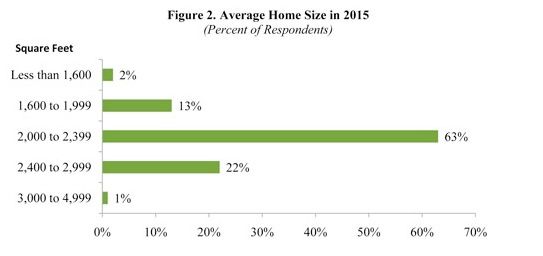
Predictions that new single-family homes would be getting smaller and greener gained currency as the downturn drove down housing prices, and survey results recently published by the National Association of Home Builders’ Economics and Housing Policy team seem to echo those predictions.
The survey results, analyzed in a study titled “The New Home in 2015,” indicate that the depth and duration of the downturn has prompted building-industry professionals to shift their expectations for what homebuyers will want as the economy recovers. Some of the findings point to trends that, if they’re sustained over the next few years, run counter to homebuilding trends that prevailed in the market only five years ago: the average, new single-family home will be smaller; living rooms will vanish or merge with other spaces, often becoming part of a great room; low-e windows and engineered wood products will be the likeliest green features.
Methods and ratings
Of the 238 survey respondents, 30% were single-family builders, 19% were architects, 26% were designers, 7% manufacturers, and 18% “other” building industry professionals. They were asked to rank their answers to many of the survey questions using a scale of 1 to 5, where 1 indicated “not at all likely” and 5 indicated “very likely.” NAHB researchers then calculated average response ratings for each question, with an average above 4.0 equivalent to a “very likely” outcome, a “somewhat likely” outcome for a rating between 3.0 and 3.9, and an “unlikely” outcome for a rating of 2.9 or lower.
Questions about home size focused on dimensions rather than rating the likelihood a particular feature would become popular, however. The average, new single-family detached home in 2015, for example, is expected to be about 2,152 sq. ft., almost 10 percent smaller than the average size of single-family homes started in the first three quarters of 2010 – 2,377 sq. ft. – and about 14% smaller than homes built in 2007, when average square footage peaked at 2,521.
Among green features, low-e windows ranked as a top priority with an average rating of 4.5, while engineered wood beams, joists, and trusses took a 4.4 rating. And even though respondents indicated consumers will be focused on lowering their heating and cooling costs, the survey results show that water efficiency (4.1) and an Energy Star rating for the whole home (also 4.1) would take precedence over installing more insulation than is required by code (3.8). Certification from the LEED for Homes program and the adoption of renewable energy systems end up with “unlikely” ratings of 2.8 and 2.7, respectively.
Fine Homebuilding Recommended Products
Fine Homebuilding receives a commission for items purchased through links on this site, including Amazon Associates and other affiliate advertising programs.

8067 All-Weather Flashing Tape

Affordable IR Camera

Reliable Crimp Connectors

Census Bureau data show that the average size of single-family homes whose construction started during the first three quarters of 2010 was 2,377 sq. ft., about 5% smaller than the peak of 2,521 sq. ft., hit in 2007. The average-size prediction for 2015, however, is 2,152 sq. ft. – almost 10% smaller than the 2010 figure and a full 14% below the 2007 average.


























